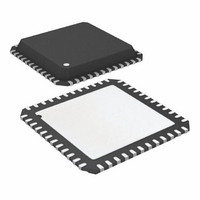ATA6603P-PLQW Atmel, ATA6603P-PLQW Datasheet - Page 66

ATA6603P-PLQW
Manufacturer Part Number
ATA6603P-PLQW
Description
MCU W/LIN TXRX REG WTCHDG 48-QFN
Manufacturer
Atmel
Series
AVR® ATA66 LIN-SBCr
Datasheet
1.ATA6603P-PLQW.pdf
(360 pages)
Specifications of ATA6603P-PLQW
Core Processor
AVR
Core Size
8-Bit
Speed
16MHz
Connectivity
I²C, LIN, SPI, UART/USART
Peripherals
Brown-out Detect/Reset, POR, PWM, WDT
Number Of I /o
23
Program Memory Size
16KB (16K x 8)
Program Memory Type
FLASH
Eeprom Size
512 x 8
Ram Size
1K x 8
Voltage - Supply (vcc/vdd)
2.7 V ~ 5.5 V
Data Converters
A/D 8x10b
Oscillator Type
Internal
Operating Temperature
-40°C ~ 125°C
Package / Case
48-QFN Exposed Pad
Lead Free Status / RoHS Status
Lead free / RoHS Compliant
Available stocks
Company
Part Number
Manufacturer
Quantity
Price
Company:
Part Number:
ATA6603P-PLQW
Manufacturer:
ATMEL
Quantity:
2 000
Part Number:
ATA6603P-PLQW
Manufacturer:
ATMEL/爱特梅尔
Quantity:
20 000
- Current page: 66 of 360
- Download datasheet (6Mb)
4.7.8.6
4.7.8.7
4.8
4.8.1
66
System Control and Reset
ATA6602/ATA6603
Resetting the AVR
Port Pins
On-chip Debug System
When entering a sleep mode, all port pins should be configured to use minimum power. The
most important is then to ensure that no pins drive resistive loads. In sleep modes where both
the I/O clock (clk
be disabled. This ensures that no power is consumed by the input logic when not needed. In
some cases, the input logic is needed for detecting wake-up conditions, and it will then be
enabled. Refer to the section
which pins are enabled. If the input buffer is enabled and the input signal is left floating or have
an analog signal level close to V
For analog input pins, the digital input buffer should be disabled at all times. An analog signal
level close to V
input buffers can be disabled by writing to the Digital Input Disable Registers (DIDR1 and
DIDR0). Refer to
able Register 0 – DIDR0” on page 279
If the On-chip debug system is enabled by the DWEN Fuse and the chip enters sleep mode, the
main clock source is enabled and hence always consumes power. In the deeper sleep modes,
this will contribute significantly to the total current consumption.
During reset, all I/O Registers are set to their initial values, and the program starts execution
from the Reset Vector. For the ATA6603, the instruction placed at the Reset Vector must be a
JMP – Absolute Jump – instruction to the reset handling routine. For the ATA6602, the instruc-
tion placed at the Reset Vector must be an RJMP – Relative Jump – instruction to the reset
handling routine. If the program never enables an interrupt source, the Interrupt Vectors are not
used, and regular program code can be placed at these locations. This is also the case if the
Reset Vector is in the Application section while the Interrupt Vectors are in the Boot section or
vice versa (ATA6602/ATA6603 only). The circuit diagram in
reset logic.
The I/O ports of the AVR are immediately reset to their initial state when a reset source goes
active. This does not require any clock source to be running.
After all reset sources have gone inactive, a delay counter is invoked, stretching the internal
reset. This allows the power to reach a stable level before normal operation starts. The time-out
period of the delay counter is defined by the user through the SUT and CKSEL Fuses. The dif-
ferent selections for the delay period are presented in
Table 4-20 on page 68
CC
I/O
“Digital Input Disable Register 1 – DIDR1” on page 262
/2 on an input pin can cause significant current even in active mode. Digital
) and the ADC clock (clk
“Digital Input Enable and Sleep Modes” on page 92
CC
/2, the input buffer will use excessive power.
defines the electrical parameters of the reset circuitry.
for details.
ADC
) are stopped, the input buffers of the device will
“Clock Sources” on page
Figure 4-15 on page 67
and
“Digital Input Dis-
50.
4921E–AUTO–09/09
for details on
shows the
Related parts for ATA6603P-PLQW
Image
Part Number
Description
Manufacturer
Datasheet
Request
R

Part Number:
Description:
MCU, MPU & DSP Development Tools Demoboard LIN-MCM
Manufacturer:
Atmel
Datasheet:

Part Number:
Description:
Microcontroller With Lin Transceiver, 5v Regulator And Watchdog
Manufacturer:
ATMEL Corporation
Datasheet:

Part Number:
Description:
DEV KIT FOR AVR/AVR32
Manufacturer:
Atmel
Datasheet:

Part Number:
Description:
INTERVAL AND WIPE/WASH WIPER CONTROL IC WITH DELAY
Manufacturer:
ATMEL Corporation
Datasheet:

Part Number:
Description:
Low-Voltage Voice-Switched IC for Hands-Free Operation
Manufacturer:
ATMEL Corporation
Datasheet:

Part Number:
Description:
MONOLITHIC INTEGRATED FEATUREPHONE CIRCUIT
Manufacturer:
ATMEL Corporation
Datasheet:

Part Number:
Description:
AM-FM Receiver IC U4255BM-M
Manufacturer:
ATMEL Corporation
Datasheet:

Part Number:
Description:
Monolithic Integrated Feature Phone Circuit
Manufacturer:
ATMEL Corporation
Datasheet:

Part Number:
Description:
Multistandard Video-IF and Quasi Parallel Sound Processing
Manufacturer:
ATMEL Corporation
Datasheet:

Part Number:
Description:
High-performance EE PLD
Manufacturer:
ATMEL Corporation
Datasheet:

Part Number:
Description:
8-bit Flash Microcontroller
Manufacturer:
ATMEL Corporation
Datasheet:

Part Number:
Description:
2-Wire Serial EEPROM
Manufacturer:
ATMEL Corporation
Datasheet:











